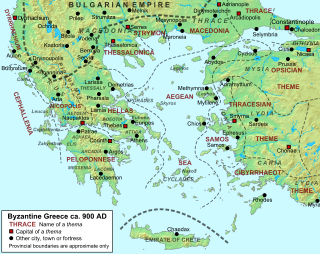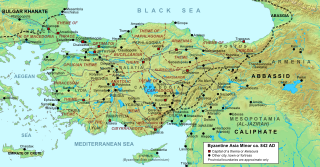Related Research Articles

Vestes was a Byzantine court title used in the 10th and 11th centuries.
Nikolaos or Nikos Oikonomides was a Greek Byzantinist, and one of the leading experts in the field of Byzantine administration.
The papias was a eunuch official in the Byzantine court, responsible for the security and maintenance of the buildings of the imperial palaces in Constantinople. He commanded an extensive staff and performed in important role in palace ceremonies. In the Palaiologan period, the honorary title of megas papias was created and awarded to senior aristocrats.

The Theme of Thessalonica was a military-civilian province of the Byzantine Empire located in the southern Balkans, comprising varying parts of Central and Western Macedonia and centred on Thessalonica, the Empire's second-most important city.

The office of the Domestic of the Schools was a senior military post of the Byzantine Empire, extant from the 8th century until at least the early 14th century. Originally simply the commander of the Scholai, the senior of the elite tagmata regiments, the Domestic quickly rose in prominence: by the mid-9th century, its holders essentially occupied the position of commander-in-chief of the Byzantine army, next to the Emperor. The office was eclipsed in the 12th century by that of the Grand Domestic, and in the Palaiologan period, it was reduced to a purely honorary, mid-level court dignity.

Vestarches was a senior Byzantine honorific dignity in use from the late 10th to early 12th centuries.

The droungarios of the Fleet, sometimes anglicized as Drungary of the Fleet, was the commander of the Imperial Fleet, the central division of the Byzantine navy stationed at the capital of Constantinople, as opposed to the provincial (thematic) fleets. From the late 11th century, when the Byzantine fleets were amalgamated into a single force under the megas doux, the post, now known as the Grand droungarios of the Fleet, became the second-in-command of the megas doux and continued in this role until the end of the Byzantine Empire.

The Theme of Strymon was a Byzantine military-civilian province (theme) located in modern Greek Macedonia, with the city of Serres as its capital. Founded probably by the mid-to-late 9th century, its history as an administrative history was chequered, being variously split up and/or united with neighbouring themes.
The sebastophoros was a high Byzantine court position and rank reserved for eunuchs in the 10th–12th centuries. Its functions are unclear.
The epi tōn deēseōn was a Byzantine office, whose holder was responsible for receiving and answering petitions to the Byzantine emperor and other Byzantine officials.
The Count of the Stable was a late Roman and Byzantine office responsible for the horses and pack animals intended for use by the army and the imperial court. From Byzantium, it was adopted by the Franks, and is the origin of the post and title of constable, via the Old French conestable.

The Theme of the Aegean Sea was a Byzantine province in the northern Aegean Sea, established in the mid-9th century. As one of the Byzantine Empire's three dedicated naval themes, it served chiefly to provide ships and troops for the Byzantine navy, but also served as a civil administrative circumscription.

The Theme of Paphlagonia was a military-civilian province of the Byzantine Empire in the namesake region along the northern coast of Anatolia, in modern Turkey.

The Theme of Cephallenia or Cephalonia was a Byzantine theme located in western Greece, comprising the Ionian Islands, and extant from the 8th century until partially conquered by the Kingdom of Sicily in 1185.

The Theme of Koloneia was a small military-civilian province of the Byzantine Empire located in northern Cappadocia and the southern Pontus, in modern Turkey. It was founded sometime in the mid-9th century and survived until it was conquered by the Seljuk Turks soon after the Battle of Manzikert in 1071.

The Theme of Seleucia was a Byzantine theme in the southern coast of Asia Minor, headquartered at Seleucia.
Ostiarios was a Byzantine court dignity reserved for eunuch palace officials.

The Count of the Tent was a Byzantine military-administrative office attested from the 8th to the early 12th centuries.

The rhaiktor was a high-ranking court position of the middle Byzantine Empire.
The dēmarchos, anglicized as Demarch, is a title historically given to officials related to civic administration. In ancient Athens the title was given to the elected chief magistrate of each of the demes of Attica. In later literature, the term was used as a translation of the Roman office of tribunus plebis. In the Byzantine Empire the dēmarchos was the leader of one of the racing factions of the Hippodrome of Constantinople. Largely concerned with ceremonial in the early centuries, from the 11th century the title was applied to various administrative positions in Constantinople, until the end of the empire. In modern usage, the term is used for the mayor of a municipality.
References
- ↑ Oikonomidès 1972, pp. 41ff..
- ↑ Kazhdan 1991, p. 2007.
- ↑ Bury 1911, pp. 10, 12.